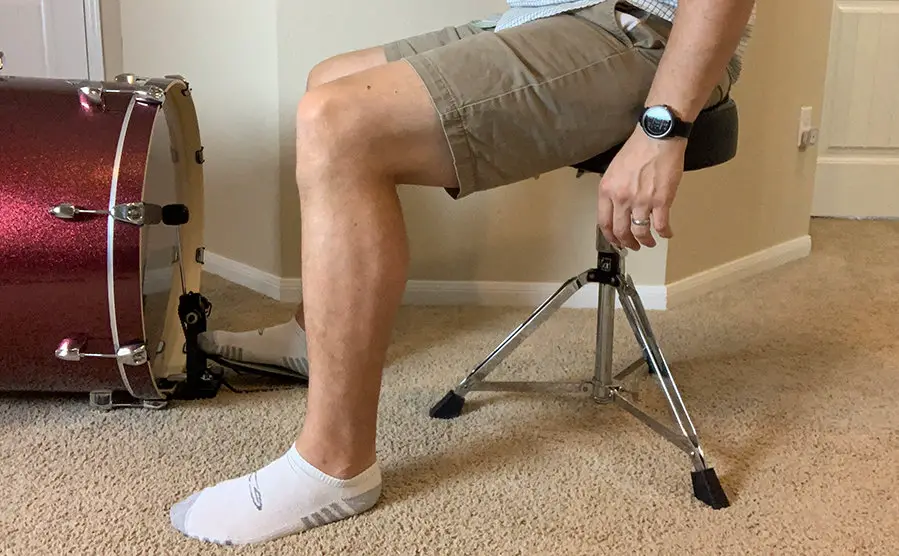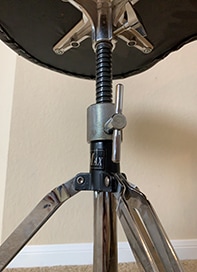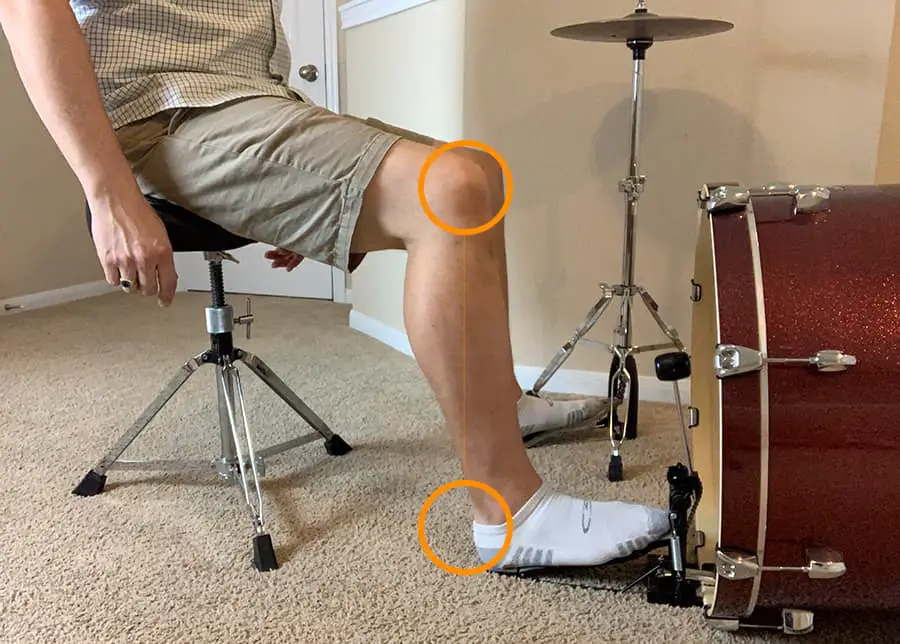
When I was first learning how to play the drums a few decades ago, I suffered from horrible posture behind the drum set. It wasn’t until a drum teacher pointed this out to me and corrected my posture on the drum stool that my world opened up and my technique improved dramatically.
Adjust the height of your throne so that your thighs are parallel to the ground and sit with your back straight. Ensure that all of your drums and cymbals are ergonomically placed so that you can reach them easily without too much torso movement.
It sounds easy, doesn’t it? The reality is that there is a lot more too it than just sitting with your back straight, so in this article I am going to walk you through the proper posture on drum throne in detail!
Adjusting the Throne Height
First things first, you are going to want to adjust the height of your drum throne so that you are sitting properly behind the kit.

The ideal lower body position for playing the drums is such that your thighs are mostly parallel to the ground. Some drummers prefer to sit higher or lower, however if you are just starting out – my recommendation is always to start with parallel thights.
TOP TIP:
A very common mistake when adjusting the height of the throne is to make the height change while not sitting behind the kit. The reason why you should be behind the kit (or at least your hi hat and bass drum) is because you will want to have your feet resting on the pedals of your kit so that you can take into account the height difference in your feet.
To properly adjust the height of your throne, follow these simple steps:
- SETUP: Start by having at least the hi-hat, snare and bass drum with pedals setup.
- PLACE THE THRONE so that when you’re sitting behind the kit, the back of your heels are directly below (and in line with) the front of your knee. This should cause your shin/calf to be not quite perpendicular to your thigh, but extended a bit.
- ADJUST THE THRONE HEIGHT so that the top of your thigh is parallel to the ground. Remember, keep your feet on the pedals when you do this so that you account for the added height of your pedal board.
- CHECK FOR COMFORT: At this point, you may decide to deviate slightly from parallel thigh in favor of a slightly higher or lower throne. This is completely personal preference, but I would try not to vary too much from the neutral position.
- LOCK IT in place by using the built in lock usually found on most thrones.

By following these steps, you’ll ensure that your throne is adjusted perfectly every time you sit down to play drums and set yourself up for success in the subsequent sections of this article!
Proper Drum Throne Sitting Technique
We are actually going to not talk about drum thrones specifically for a few minutes here because proper sitting technique is something which I have implemented in a much broader sense, and it has made all the difference in the world.
Now – here’s a fun little test: The next time you notice someone sitting in a chair with bad back posture, point it out to them. What you will find is that they IMMEDIATELY go to straighten out their back and feign proper back posture.
Did you know, that this is actually the opposite of what you want to do?
Proper sitting technique starts in the pelvis. More specifically the forward rotation of the pelvis itself. By starting your sitting motion with the pelvis rotated forward, you are doing two things:
- You are pushing your rear end out behind you a little bit
- You’re naturally creating natural curvature of your spine!
So – the next time you go to sit down, concentrate on sticking your butt out just a little bit with a slight rotation of the pelvis forward. By sitting butt-first, you’ll create a very natural sitting posture with a beautifully straight spine that is much easier to sustain.
It is important to note that the above advice can be taken too far. If you google ‘anterior pelvic tilt’, you’ll see all sorts of articles and videos about the extreme end of over-posturing, which you want to avoid. You should aim for a nice comfortable sitting position that isn’t too extreme either forward or backward.
QUESTION:
Now that you have this bit of knowledge, what will you do if someone were to point out your bad posture?
ANSWER:
If your answer was to stand up and sit back down properly, you are 100% correct!
So, let’s apply this concept to the drum kit. Next time you go to practice, stand in front of your throne and purposely practice sitting with your pelvis rotated forward slightly. You’ll find that with this good posture, you’ll open up your upper body significantly with increased torso rotation capabilities, while at the same time avoiding long term damage to your back!
Drum and Cymbal Placement
Any instrument, no matter what it is should be a natural extension of the human body. Drums are definitely no different. As such, if we are talking about proper positioning of the body in relation to the drum throne, we should also talk about its position in front of the drums.
Drums (and percussion for that matter) are unique because we typically use a set of tools to play them. Yes – drumsticks! As such, it’s important to factor your sticks into the act of properly setting up your drums.
Ideally, your upper body position shouldn’t have to change much when you’re playing, with the exception of some torso rotation. In other words, when you are playing, your arms should be doing the majority of the work to get your drum sticks into position to play a drum!
So, when setting up a drum kit, I like to sit behind the kit and explore it ergonomically with my sticks. Making sure you can easily reach all of the instruments in a drum set without excessive upper body movement is key to maintaining your proper posture behind the kit!
Balance While Playing
I’m sure you remember when you were first starting to play the drums and how awkward you felt behind the kit with both feet on your pedal. Or maybe you are there right now.
The first few times you pick up your foot to play the bass drum pedal will likely be an exercise in balance and upper body control.
By focusing on proper drum throne setup and posture, you can help “ground yourself” onto the drum throne and in turn help you to maintain your balance behind the kit.
TOP TIP:
A good exercise to do is to focus on sitting properly on the drum throne, lean back and lift both your feet off of the ground. Get a good sense for what that feeling is like. It’s a bit like learning the balance skills involved in riding a bike – and will also stay with you as you play, just like learning to ride a bike.
Related Questions
How do you adjust drum throne height?
Rotating the throne counterclockwise will raise the level and vice versa on most contemporary models. There is usually a locking mechanism on the threads as well which allow you to ‘save’ the height of the throne. Some older drum thrones are much simpler and adjust height via a series of holes through which a bolt keeps the height in place. This is quite rare with today’s hardware though as it is generally more difficult to achieve quick adjustment.
Is drumming bad for your back?
If you practice while severely hunched forward, there is a pretty good chance that over time you will cause some sort of injury to your back, especially if you are putting in long hours. Practicing proper posture will help protect your back from injury.
